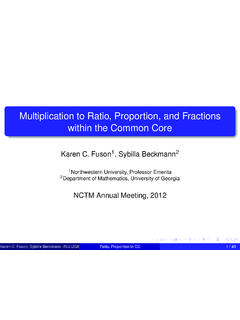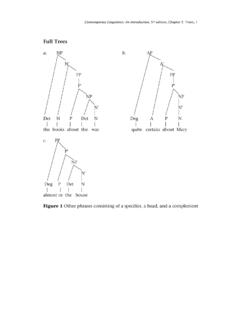Transcription of Number Theory: A Contemporary Introduction Pete L. Clark
1 Number theory : A Contemporary IntroductionPete L. ClarkContentsChapter 1. The Fundamental Theorem and Some Applications71. Foundations72. The Fundamental Theorem (inZ)113. Some examples of failure of unique factorization154. Consequences of the fundamental theorem175. Some Irrational Numbers246. Primitive Roots27 Chapter 2. Pythagorean Triples311. Parameterization of Pythagorean Triples312. An Application: Fermat s Last Theorem forN= 4353. Rational Points on Conics37 Chapter 3. Quadratic Rings411. Quadratic Fields and Quadratic Rings412. Fermat s Two Squares Theorem413. Fermat s Two Squares Theorem Lost444. Fermat s Two Squares Theorem (and More!)
2 Regained455. Composites of the Formx2 Dy248 Chapter 4. Quadratic Reciprocity511. Statement of Quadratic Reciprocity522. The Legendre Symbol523. Motivating Quadratic Reciprocity I: Bonus Theorems554. Motivating Quadratic Reciprocity II: Direct and Inverse Problems595. The Jacobi Symbol616. Preliminaries on Congruences in Cyclotomic Rings637. Proof of the Second Supplement648. Proof of the Quadratic Reciprocity Law Computation of the Gauss Sum6710. Comments68 Chapter 5. More Quadratic Reciprocity: from Zolotarev to Duke-Hopkins691. Quadratic Reciprocity in a Finite Quotient Domain692. The Kronecker Symbol713. The Duke-Hopkins Reciprocity Law714.
3 The Proof735. In 6. The Mordell Equation771. The Coprime Powers Trick inZ7734 CONTENTS2. The Mordell Equation783. The Coprime Powers Trick in a UFD794. Beyond UFDs825. Remarks and Acknowledgements85 Chapter 7. The Pell Equation871. Introduction872. Example: The equationx2 2y2= 1883. A result of Dirichlet914. Existence of Nontrivial Solutions925. The Main Theorem936. A Caveat947. Some Further Comments94 Chapter 8. Arithmetic Functions971. Introduction972. Multiplicative Functions983. Divisor Sums, Convolution and M obius Inversion1034. Some Applications of M obius Inversion106 Chapter 9. Asymptotics of Arithmetic Functions1091.
4 Introduction1092. Lower bounds on Euler s totient function1103. Upper bounds on Euler s function1124. The Truth About Euler s Function1135. Other Functions1156. Average orders116 Chapter 10. The Primes: Infinitude, Density and Substance1211. The Infinitude of the Primes1212. Bounds1263. The Density of the Primes1274. Substance1295. Euclid-Mullin Sequences131 Chapter 11. The Prime Number Theorem and the Riemann Hypothesis1331. Some History of the Prime Number Theorem1332. Coin-Flipping and the Riemann Hypothesis136 Chapter 12. The Gauss Circle Problem and the Lattice Point Enumerator1411. Introduction1412. Better Bounds1443.
5 Connections to average values146 Chapter 13. Minkowski s Convex Body Theorem1491. The Convex Body Theorem1492. Diophantine Applications156 Chapter 14. The Chevalley-Warning Theorem1631. The Chevalley-Warning Theorem1632. Two proofs of Warning s theorem165 CONTENTS53. Some Later Work170 Chapter 15. Additive Combinatorics1731. The Erd os-Ginzburg-Ziv Theorem1732. The Combinatorial Nullstellensatz1773. The Cauchy-Davenport Theorem179 Chapter 16. Dirichlet Series1811. Introduction1812. Some Dirichlet Series Identities1853. Euler Products1864. Absolute Convergence of Dirichlet Series1885. Conditional Convergence of Dirichlet Series1916.
6 Dirichlet Series with Nonnegative Coefficients1927. Characters and L-Series1938. An Explicit Statement of the Riemann Hypothesis1969. General Dirichlet Series197 Chapter 17. Dirichlet s Theorem on Primes in Arithmetic Progressions1991. Statement of Dirichlet s Theorem1992. The Main Part of the Proof of Dirichlet s Theorem2003. Nonvanishing ofL( ,1)205 Chapter 18. Rational Quadratic Forms and the Local-Global Principle2071. Rational Quadratic Forms2092. Legendre s Theorem2113. Hilbert s Reciprocity Law2144. The Local-Global Principle2165. Local Conditions for Isotropy of Quadratic Forms219 Chapter 19. Representations of Integers by Quadratic Forms2211.
7 The Davenport-Cassels Lemma2222. The Three Squares Theorem2243. Approximate Local-Global Principle2284. The 15 and 290 Theorems230 Appendix A. Rings, Fields and Groups2331. Rings2332. Ring Homomorphisms2353. Integral Domains2364. Polynomial Rings2385. Commutative Groups2396. Ideals and Quotients242 Appendix B. More on Commutative Groups2471. Reminder on Quotient Groups2472. Cyclic Groups2483. Products of Elements of Finite Order in a Commutative Group2494. Character theory of Finite Abelian Groups2515. Proof of the Fundamental Theorem on Finite Commutative Groups2586. Wilson s Theorem in a Finite Commutative Group2616 CONTENTSA ppendix C.
8 More on Polynomials2651. Polynomial Rings2652. Finite Fields266 Appendix. Bibliography269 CHAPTER 1 The Fundamental Theorem and Some Applications1. FoundationsWhat is Number theory ?This is a difficult question: Number theory is an area, or collection of areas, ofpure mathematics that has been studied for over two thousand years. As such, itmeans different things to different people. Nevertheless the question is not nearlyas subjective as What is truth? or What is beauty? : all of the things variouspeople call Number theory are related, in fact deeply and increasingly so over you think about it, it is hard to give a satisfactory definition of any area ofmathematics that would make much sense to someone who has not taken one ormore courses in it.
9 One might say that analysis is the study of limiting processes,especially summation, differentiation and integration; that algebra is the study ofalgebraic structures like groups, rings and fields; and that topology is the studyof topological spaces and continuous maps between them. But these descriptionsfunction more by way ofdramatis personaethan actual explanations; less preten-tiously, they indicate (some of) theobjectsstudied in each of these fields, but theydo not really tell us which properties of these objects are of most interest and whichquestions we are trying to answer about them. Such motivation is hard to providein the abstract much easier, and more fruitful, is to give examples of the types ofproblems that mathematicians in these areas are or were working on.
10 For instance,in algebra one can point to the classification of finite simple groups, and in topologythe Poincar e conjecture. Both of these are problems that had been open for longperiods of time and have been solved relatively recently, so one may reasonablyinfer that these topics have been central to their respective subjects for some are the objects of Number theory analogous to the above description? Agood one sentence answer is that Number theory is the study of the integers, ,the whole numbers and their course this is not really satisfactory: astrology, accounting and computer sci-ence, for instance, could plausibly be described in the same way. What propertiesof the integers are we interested in?










